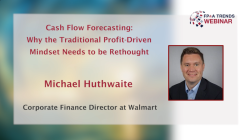In this blog series, the author provides a comprehensive approach to the design, construction, roll-out and maintenance of a modern driver-based planning solution. Here, he focuses on determining the decisions the model is to support and outlines why understanding the factors on which the decisions will be made is crucial.
In this series of blogs, the author will be providing a comprehensive approach to the design, construction, roll-out and maintenance of a modern analytic driver-based model. He also outlines several necessary requirements for building this model successfully.
In this video, Michael Huthwaite, Corporate Finance Director at Walmart, explains how you can change the playbook and create real value for your business.
In this short video, Marat Lomakov, Finance Director, Europe Supply Chain at Ecolab, shares his insights on effective strategies such as the adoption of xP&A and Scenario Planning to help you learn how to address an enormous number of disruptions in a changing business world.
Enhanced Driver-Based Planning and Forecasting within the organisation is an essential part of the roadmap toward modern Financial Planning and Analysis (FP&A).
Today, many companies are intrigued about what ML can do for their company and are waiting to know what it could mean for their finance function. Based on conversations held with many experts in the financial planning process, in this article Gizelda describes the top 5 desired outcomes that are cited as being necessary for ML to be perceived as adding value:
Pagination
Subscribe to
FP&A Trends Digest

We will regularly update you on the latest trends and developments in FP&A. Take the opportunity to have articles written by finance thought leaders delivered directly to your inbox; watch compelling webinars; connect with like-minded professionals; and become a part of our global community.






